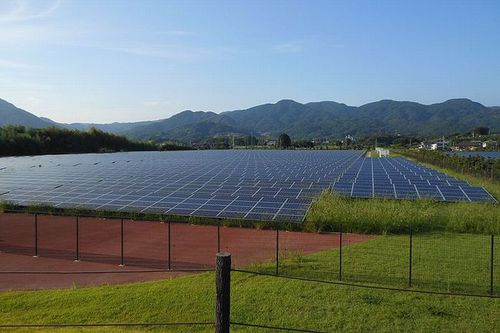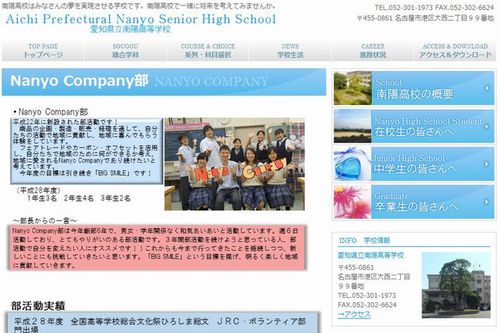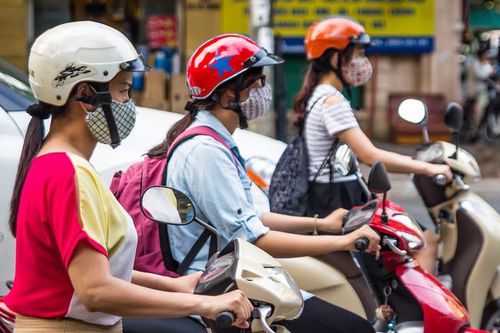Current Status of Renewable Energy in Japan
JFS Newsletter No.176 (April 2017)

Image by Pekachu Some Rights Reserved.
In this issue of the JFS Newsletter, we show the current status of renewable energy in Japan at three levels: the national level, by service area of each of the regional power companies, and the municipal or prefectural level. This information is based on "Sustainable Zone 2016" ("Eizoku Chitai" in Japanese) published in March 2017 by a research laboratory led by Professor Hidefumi Kurasaka at Chiba University and the Institute for Sustainable Energy Policies (ISEP), an authorized nonprofit organization (NPO).
High School Students Win Special Award for Developing Carbon-Offsetting Products

Nanyo Company Club of Nanyo Senior High School website.
The Nanyo Company Club of Nanyo Senior High School in Kyoto was awarded a Special Prize at the Fifth Carbon Offset Awards sponsored by the Ministry of the Environment on Dec. 11, 2015. The group received praise for their initiatives to offset carbon by actively developing original products in cooperation with a local food manufacturer, aiming to make contributions in the area.
Carbon offset is a strategy that involves the purchasing of credits equal to the volume of future greenhouse gas emissions and to use these credits to offset such emissions. The Nanyo Company Club purchases credits equivalent to the gas emissions generated during the manufacture and sale of products. In order to make further local contributions, the group uses credits created by maintaining a water conservation forest in the region.
Many of their products are obtained through fair trade in addition to the application of carbon offset credits. The group aims to raise awareness toward solutions for child labor and poverty around the world by selling its products. The introduction of fair trade and carbon offset inspired the development of new products for the region by club members.
Carbon offset and fair trade schemes are not yet widely recognized in Japan, and the group members are eager to spread information to as many people as people as possible.
Japanese Institute Develops Environmental Impact Evaluation System for East Asia

Image by Robert_z_Ziemi.
The National Institute for Environmental Studies, Japan (NIES) announced on December 19, 2016, that it had published a NIES Research Project Report on the "East Asian Environmental Research Program" (priority research program) for FY2011 to FY2015. Under this program, projections were made for the future environment of East Asia using a multi-scale model that integrates three models (atmospheric, terrestrial, and oceanic) and involves various pollution media (polluting substances and contributing factors). The research provided new insight by quantitatively evaluating the environmental impacts of various measures to prevent atmospheric and terrestrial pollution.
In the East Asian region, environmental problems have been increasing along with rapid economic growth, and they have affected Japan in tangible ways, including regional trans-boundary pollution. The research program investigated the actual status and mechanisms of atmospheric and marine pollution, which are typical environmental problems in the region, by integrating observations and simulations to build a system that quantitatively evaluates the relationship between environmental impacts and the responses.
In air pollution research, multi-scale observations were implemented (from the hemispheric scale to the Northeast Asian regional and city scales). Based on the results, air-quality models were improved to reproduce the current air pollution trends. The research also looked into the impacts of ozone on plants, impacts of particulate matter on human health, and levels of contribution of Japan and other countries to air pollution.
In marine pollution research, a model was developed to predict pollution loads based on observations along the basin of the Yangtze River in China. The continental shelf ecosystem was also studied based on the observations in the East China Sea and laboratory experiments. A model was then developed to predict the marine environment's responses to pollution loads from terrestrial sources.
In collaboration with the Center for Social and Environmental Systems Research (also based at NIES), scenarios were then developed for emissions dynamics of air and water pollution substances, looking at the near future (up to around 2030). Using methods developed in this research program, the effectiveness of measures (including the measures to prevent atmospheric and terrestrial pollution) to protect the environment in East Asia was evaluated quantitatively. The multi-scale model integrates three models (atmosphere, terrestrial, and marine) and makes use of various pollution media.
For the development of sustainable society and to address trans-boundary pollution in the East Asia region, strategies are needed to develop bilateral or multilateral frameworks. However, until now there has not been a sufficient effort to develop and utilize scientific methods to evaluate the quantitative relationships between regional pollution and environmental impacts of human activities. That kind of information is an essential foundation for such strategies.
The results of this research program will be useful for discussions about integrated measures for integrated management of the atmospheric, terrestrial, and marine environments in East Asia.
Takenaka Expands Users of Proprietary Wood Technology for Seismic Upgrades, Building Structural Components

Copyright 2017 Takenaka Corp. All Rights Reserved.
Due to deregulation and efforts to revitalize Japan's domestic forestry industry, the use of wood in buildings is drawing attention. Takenaka Corp., a leading Japanese construction company, is promoting the use of wood in buildings by providing its wood utilization technology to other companies. With permission from Smart Japan, a news site that provides the latest information on the conservation, storage and generation of electricity, we translated and print here an article on Takenaka's efforts, originally published on December 12, 2016.
Takenaka was an exhibitor at Eco-Products 2016 (December 8 to 10 at Tokyo Big Sight), one of the largest environmental exhibitions in Japan, where the company showcased many of its construction technologies utilizing wood. The company's seismic retrofit technology (T-FoRest) that utilizes wood was awarded the 13th Eco-Products Award by Japan's Ministry of Land, Infrastructure, Transport and Tourism. Takenaka has been using the technology mainly in its own facilities, but due to the increase of wood use for buildings in Japan, the company has recently concluded licensing agreements with construction companies. By allowing other companies to use its technology, Takenaka plans to promote the overall use of wood in construction.
At the exhibition, Takenaka displayed two technologies to improve the earthquake-resistance of buildings. The first one was "T-FoRest" that utilizes laminated veneer lumber (LVL), cross-laminated timber (CLT) and other engineered wood products. At the booth, the company introduced "T-FoRest Light," which uses wood in place of steel braces and earthquake-resistant wood walls, dubbed "T-FoRest Wall," to replace reinforced concrete walls.
Steel braces are regularly used in building openings as a seismic retrofitting method. T-FoRest Light replaces steel with engineered wood products having equivalent strength. Springs attached at the edge of engineered wood braces apply tension to secure the structural components. Thus, engineered wood bracing does not require the joining work that would be needed when using steel, such as welding and gluing.
The T-FoRest Wall, which uses CLT and LVL panels instead of seismic-resistant reinforced concrete walls, also has benefits in terms of construction. It takes half the time to put up compared to conventional reinforced concrete walls, as components can be carried onsite on wagons as separate CLT panels and assembled in place where reinforcement is necessary, by securing posts, joists and panels with special adhesives.
The T-FoRest Wall technology has been introduced at three construction sites, and consideration is under way for three more sites. So far it has been utilized only in buildings that Takenaka Corporation has designed and constructed, but Takenaka has now signed construction licensing agreements with three companies engaged in seismic retrofitting: Sho-Bond Corporation, Bond Engineering and Toho Earthtech. It plans to expand the application of T-FoRest Wall in seismic retrofitting, which can be done while the building is in use. The contracts stipulate the use of Takenaka's T-FoRest performance certification and patents related to the utilization of the technology. The technology is not limited to use in public or private buildings, but is limited to uses covered by the performance certification.
The second technology introduced at the booth is a fire-resistant engineered wood, dubbed "Moen-Wood," meaning incombustible wood in Japanese. The material is made of three layers: a load-bearing wood layer, incombustible layer made of mortar and wood, and combustible wood layer. It can be used as structural components including posts and beams. In a fire, the outer combustible layer becomes char, providing good thermal insulation and protecting the inner wood from being burned.

Copyright 2017 Takenaka Corp. All Rights Reserved.
The incombustible layer consists of alternating layers of mortar and engineered wood. Mortar absorbs heat to shut out flames and protects the core load-bearing layer from flames. Even in a fire, the temperature of the load-bearing component carrying the building load is kept below 260 degrees Celsius. The Moen-Wood has been certified by the Minister of Land, Infrastructure and Transportation as a one-hour fire-resistant structural building material under Japan's Building Standards Act. Projects using Moen-Wood construction technology do not require special approvals to build, so they follow the same process as with other structures such as reinforced concrete and steel, if the spans of up to about nine meters between posts. Moen-Wood had been introduced in six projects at the time of the original article.
Takaneka intends to enter into licensing agreements for manufacturing and sales of Moen-Wood with other companies. Agreements were expected with three manufacturers by the end of 2017: Saito Wood Industry, Toju Corporation and Meiken Lamwood Corporation. The technology is only applicable to construction projects contracted by national institutions and local governments at the moment, but Takenaka plans to expand the scope of applications in the future.
Source: Smart Japan (in Japanese)
Japan for Sustainability (JFS) is a non-profit communication platform to
disseminate environmental information from Japan to the world. We are
grateful that people in 191 countries have found an interest in our free
e-mail publications, and will continue to do our best to deliver useful
information to our readers all around the globe.
Please feel free to forward this message to your colleagues and friends
wherever the Internet can reach. If you know colleagues or friends there
with an interest in sustainability, please do forward them one of our
newsletters and invite them to try our service. To subscribe for JFS
Newsletters, visit www.japanfs.org/en/newsletter/subscribe.html

If you find our information and activities unique and valuable,
we appreciate your support!
http://www.japanfs.org/en/join/donation.html

Use this form http://www.japanfs.org/acmailer/unsubscribe.html to
remove your email address from our mailing list.

We welcome your comments. Please send them to: info@japanfs.org

Japan for Sustainability (JFS)
 |  |  |
Copyright (c) 2017, Japan for Sustainability. All Rights Reserved.

